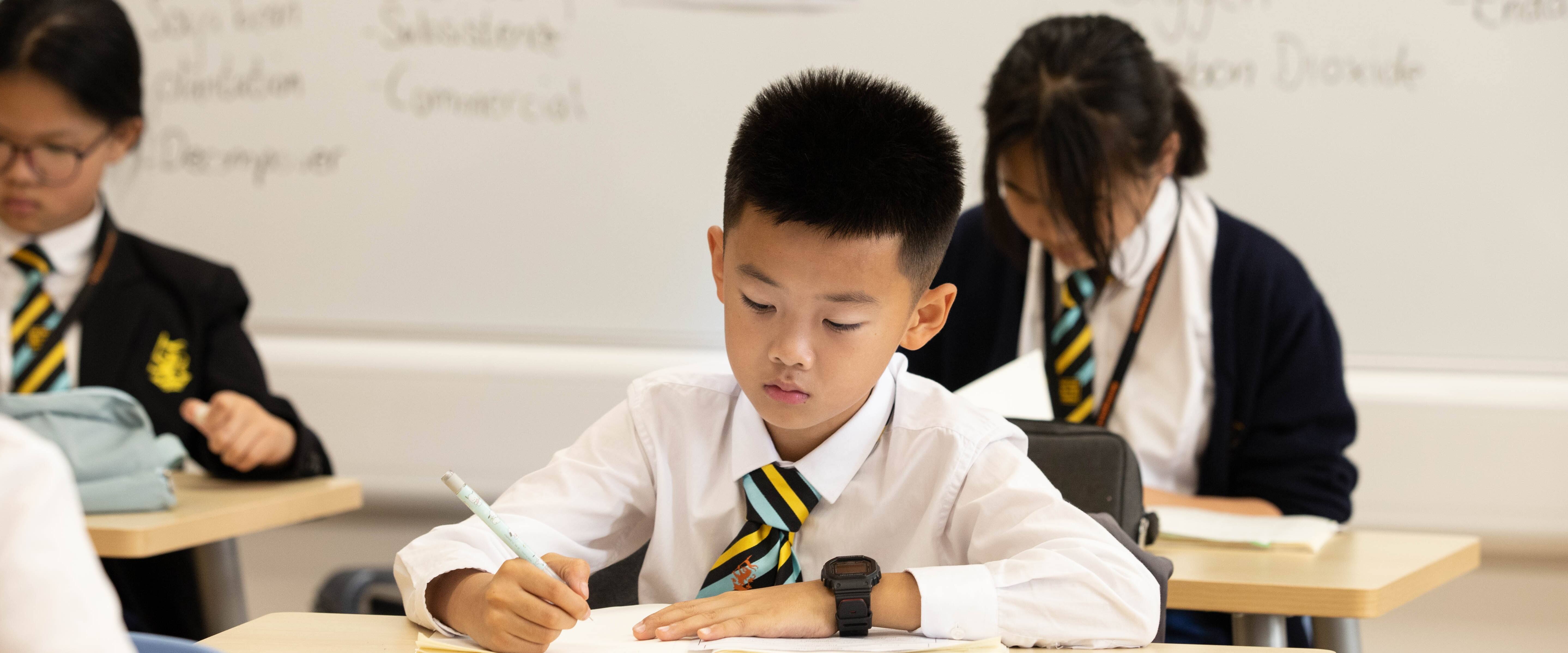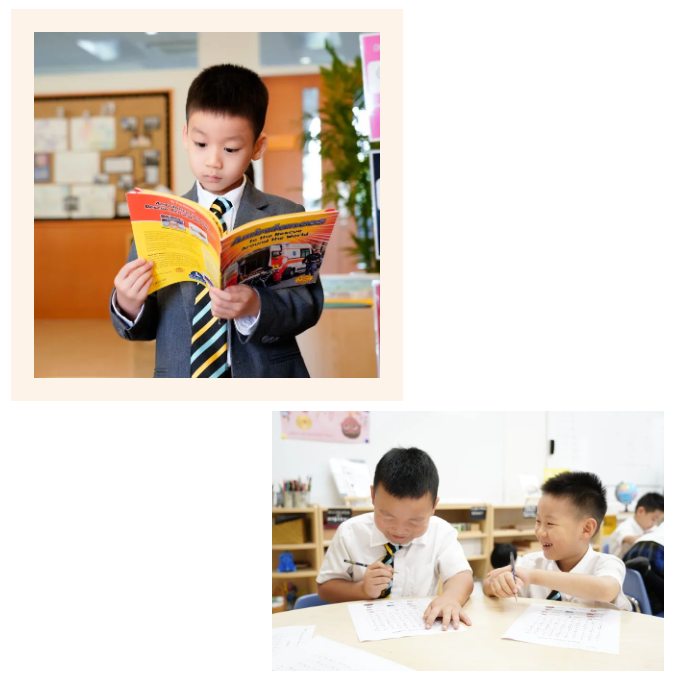
Is your child not interested in learning English? Are they easily distracted when reading English?
Is your child afraid to speak English? Are they struggling with pronunciation?
Is your child finding it hard to spell the right word? Is it hard for them to memorise English words?
Is it hard for them to write an article in English?
When you are at the lower primary of Hiba Academy Hangzhou, you will see how our Hiba pupils acquire English in an enabling environment. They confidently talk to their expat teachers and read English books quietly and attentively. They are cultivating a lifelong love of learning, which is the core of learning a language.
Why do Hiba pupils love learning English? It is thanks to the entertaining and immersive English environment.

Our immersive language learning environment
The Broca area, a region in the brain hemisphere with functions linked to speech production, is most active between the ages of 4 and 12. This is why educators call this time the critical period of language learning. Children’s brains at this stage are still developing, their facial muscles are more flexible, and they are better at recognising sounds, allowing them to acquire a second language more easily. Therefore, finding an authentic language learning environment is conducive to language acquisition. This is where Hiba Academy Hangzhou shines. Every teacher at Hiba English department, and many other departments, are native English speakers with rich teaching experiences, creating an immersive language environment where English is embedded across our curriculum to ensure maximum exposure for our pupils. As a result, English surrounds our children to develop a safe, secure, and open atmosphere that gives pupils the confidence to take risks and experiment with language learning.
At Hiba Academy Hangzhou Lower Primary, we aspire to create a community of immersive, high-quality teaching in which children develop a lifelong love of learning. Teachers conduct weekly teaching research that caters to the interests of our pupils in this immersive English environment.
Quality teaching is only achieved over time and by setting unfeasible goals. We set up a clear structure integrated within progressive, achievable, and tangible outcomes that enable the children to learn about and analyse the world around them. Children need to feel a sense of belonging to their school and classroom. When talking about English learning, we always emphasise the importance of keeping a high interest because interest is the best teacher. Learning vocabulary, sentence structures, grammar and other separate linguistic knowledge can be boring for pupils and detrimental to their interest in learning. Meanwhile, learning linguistic knowledge disconnected from reality will not be likely to suffice their needs for future university application or career development. So, how do we realise the balance?
English class - Talk 4 Writing
Our children learn to speak, read and write English through high-quality English texts in their English lessons. Our children access their learning through the Talk for Writing approach that allows children to internalise English through ‘talking the text’.
The teacher leads the storytelling at this stage. He talks out the story and gives various body language to show the story along.
After the above stage, pupils lead the storytelling now. They tell the story with body language. The teacher does not speak at this stage; instead, he prompts pupils with some body language.
By allowing our children to imitate the text and embody their reading, pupils move from dependent on teacher support to independent users of the English language.
In addition, our children are incentivised to experiment with their learning to implement the skills they have built up to expand their broader literary understanding. Children are encouraged to share their ideas using their pre-existing knowledge and target vocabulary to link their learning, thoughts, and ideas.
Phonics Lessons
To create a solid foundation of speaking, reading and writing, it is essential to understand how these skills are intertwined and how they support the learning of one another. In Lower Primary, we focus on reading and speaking as two inseparably linked skills. Therefore, we apply the Phonics strategy, a thorough and highly supported teaching programme that allows children to connect and expand their understanding of the English language and consequently acquire greater fluency and a deeper comprehension of the texts they are exposed to. At Hiba Lower Primary, children are divided into small, separate groups to deliver their learning in a comfortable, holistic setting. Pupils learn letters and their corresponding sounds by learning to read through phonics as they learn to blend the sounds, decode unfamiliar words and define them using contextual cues.

Our pupils are split into groups based on their current English performance so we can help them address their specific challenges. Pupils’ performances are tracked, and they can move from one group to another according to their progress. For example, from the following group settings, it can be found that the learning outcomes and difficulties increase from left to right, allowing our pupils to read a word when they see it and spell it out when they hear it. _1669187789845.png)
It also broadens the vocabulary they can read, write and use in their everyday English learning. When our children complete Grade 2 and begin their Upper Primary education, they can access a wide range of texts, freely selecting their reading material.
Please click the photo to learn more about how our bilingual pupils learn through the phonics programme at Hiba Academy Hangzhou.
Project Based Learning
English is not a 40-minute-a-day lesson. Children use English to explore, research and discover in their daily lives. Alongside their English and Phonics classes, children can apply and broaden their speaking, reading and writing through Project Based Learning (PBL). That underpins everything we do as a school. They can integrate their learning across their shared curriculum and apply their speaking, reading and writing in all aspects of their schooling. Meanwhile, by widening our children’s worldview through inquiry-based learning, we further widen their foundation, creating a lifelong love of learning.

How a PBL unit is structured
A typical PBL unit starts with the children exploring their environment and selecting resources they think are exciting and worthy of investigation. When the class agree on a topic, they share their ideas, expressing what they like about the unit and what they wish to know more about. These class discussions form the basis of the unit’s investigation, with the children asking a range of questions about their chosen topic that are recorded and displayed as continuous provision. Later, the class will use their library, outdoor learning and morning activity time to gather more information to broaden their understanding further. The topic the children have chosen, their areas of interest and questions will shape the class’s learning journey and drive the learning forward in a fun, exciting and accessible way.
Each day at Hiba Academy Hangzhou, our children can investigate their individual and group ideas to enrich their learning and strengthen their understanding by teaching the two languages. Giving our children the agency to learn on their terms opens the world to them in a fascinating and captivating way, enthralling them in their unique learning journey where they are more confident of thriving on an international stage.